HSC230 Cultural Safety in Healthcare: Values, Beliefs & Behaviors
VerifiedAdded on 2023/04/26
|8
|1829
|329
Essay
AI Summary
This essay provides a comprehensive reflection on cultural safety in healthcare, utilizing a mind map to visually represent personal values, beliefs, and behaviors. It delves into how these individual attributes can influence clinical practice and impact the quality of care provided to patients from diverse cultural backgrounds. The reflection examines the importance of self-awareness, empathy, and respect in creating a culturally safe environment, while also acknowledging potential biases and challenges that may arise. By integrating peer-reviewed literature, the essay analyzes how these attributes contribute to or detract from being a culturally safe practitioner in a multicultural healthcare setting, emphasizing the need for continuous learning and adaptation to ensure equitable and respectful care for all patients. The essay also looks into the concepts of dependability, honesty, compassion, respect, empathy, time management, christianity, self-empowerment, equity and mental health.
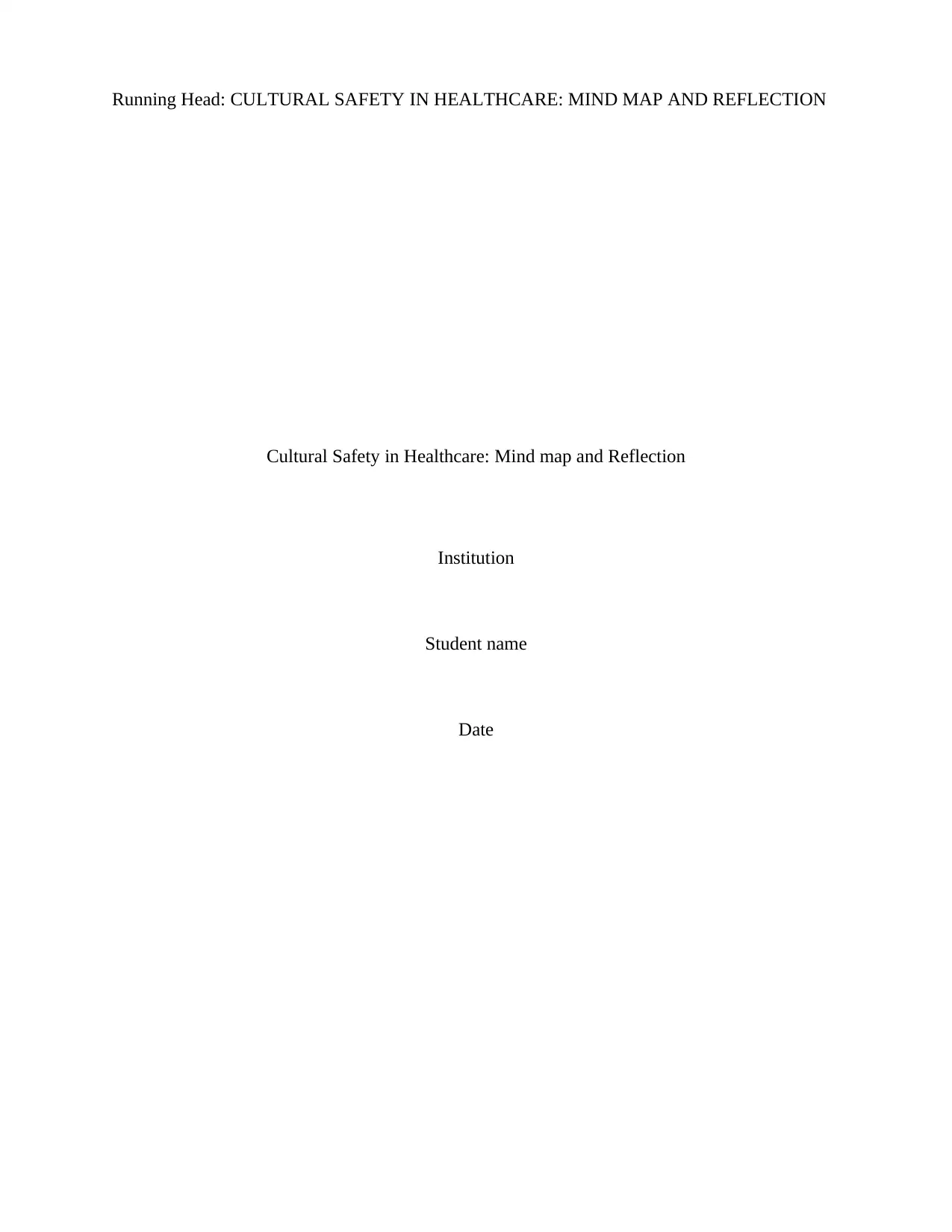
Running Head: CULTURAL SAFETY IN HEALTHCARE: MIND MAP AND REFLECTION
Cultural Safety in Healthcare: Mind map and Reflection
Institution
Student name
Date
Cultural Safety in Healthcare: Mind map and Reflection
Institution
Student name
Date
Paraphrase This Document
Need a fresh take? Get an instant paraphrase of this document with our AI Paraphraser
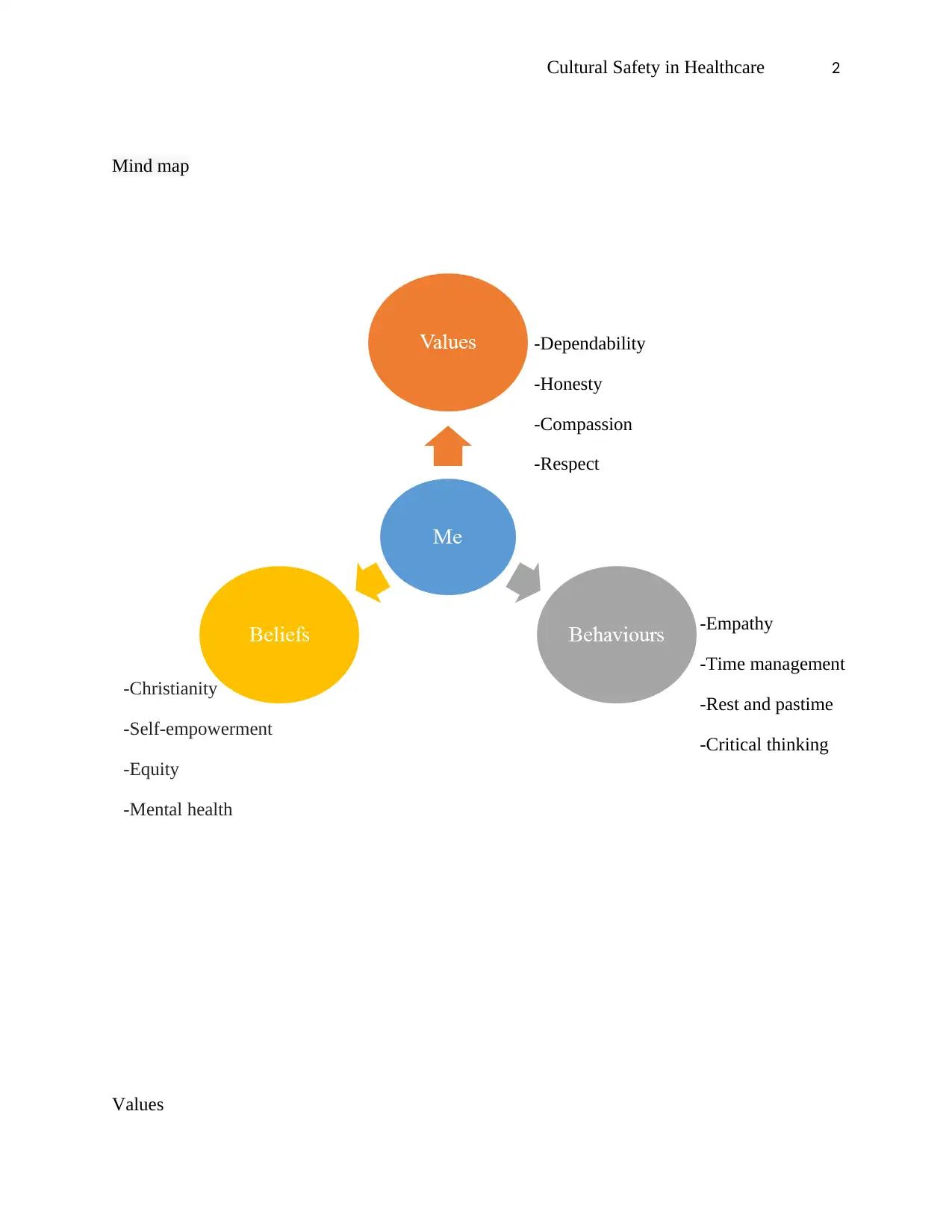
-Dependability
-Honesty
-Compassion
-Respect
-Christianity
-Self-empowerment
-Equity
-Mental health
-Empathy
-Time management
-Rest and pastime
-Critical thinking
-Dependability
-Honesty
-Compassion
-Respect
Cultural Safety in Healthcare 2
Mind map
Values
-Honesty
-Compassion
-Respect
-Christianity
-Self-empowerment
-Equity
-Mental health
-Empathy
-Time management
-Rest and pastime
-Critical thinking
-Dependability
-Honesty
-Compassion
-Respect
Cultural Safety in Healthcare 2
Mind map
Values
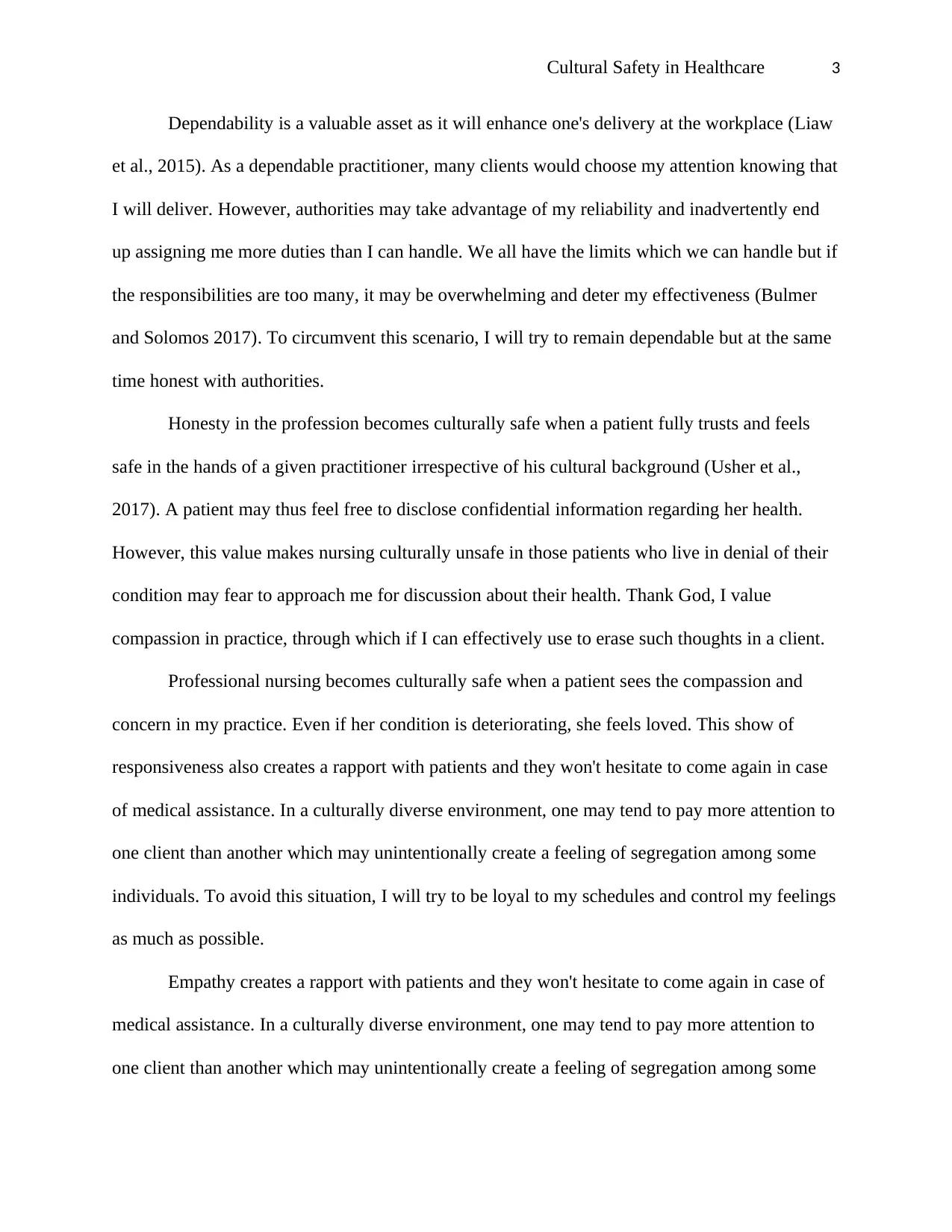
Cultural Safety in Healthcare 3
Dependability is a valuable asset as it will enhance one's delivery at the workplace (Liaw
et al., 2015). As a dependable practitioner, many clients would choose my attention knowing that
I will deliver. However, authorities may take advantage of my reliability and inadvertently end
up assigning me more duties than I can handle. We all have the limits which we can handle but if
the responsibilities are too many, it may be overwhelming and deter my effectiveness (Bulmer
and Solomos 2017). To circumvent this scenario, I will try to remain dependable but at the same
time honest with authorities.
Honesty in the profession becomes culturally safe when a patient fully trusts and feels
safe in the hands of a given practitioner irrespective of his cultural background (Usher et al.,
2017). A patient may thus feel free to disclose confidential information regarding her health.
However, this value makes nursing culturally unsafe in those patients who live in denial of their
condition may fear to approach me for discussion about their health. Thank God, I value
compassion in practice, through which if I can effectively use to erase such thoughts in a client.
Professional nursing becomes culturally safe when a patient sees the compassion and
concern in my practice. Even if her condition is deteriorating, she feels loved. This show of
responsiveness also creates a rapport with patients and they won't hesitate to come again in case
of medical assistance. In a culturally diverse environment, one may tend to pay more attention to
one client than another which may unintentionally create a feeling of segregation among some
individuals. To avoid this situation, I will try to be loyal to my schedules and control my feelings
as much as possible.
Empathy creates a rapport with patients and they won't hesitate to come again in case of
medical assistance. In a culturally diverse environment, one may tend to pay more attention to
one client than another which may unintentionally create a feeling of segregation among some
Dependability is a valuable asset as it will enhance one's delivery at the workplace (Liaw
et al., 2015). As a dependable practitioner, many clients would choose my attention knowing that
I will deliver. However, authorities may take advantage of my reliability and inadvertently end
up assigning me more duties than I can handle. We all have the limits which we can handle but if
the responsibilities are too many, it may be overwhelming and deter my effectiveness (Bulmer
and Solomos 2017). To circumvent this scenario, I will try to remain dependable but at the same
time honest with authorities.
Honesty in the profession becomes culturally safe when a patient fully trusts and feels
safe in the hands of a given practitioner irrespective of his cultural background (Usher et al.,
2017). A patient may thus feel free to disclose confidential information regarding her health.
However, this value makes nursing culturally unsafe in those patients who live in denial of their
condition may fear to approach me for discussion about their health. Thank God, I value
compassion in practice, through which if I can effectively use to erase such thoughts in a client.
Professional nursing becomes culturally safe when a patient sees the compassion and
concern in my practice. Even if her condition is deteriorating, she feels loved. This show of
responsiveness also creates a rapport with patients and they won't hesitate to come again in case
of medical assistance. In a culturally diverse environment, one may tend to pay more attention to
one client than another which may unintentionally create a feeling of segregation among some
individuals. To avoid this situation, I will try to be loyal to my schedules and control my feelings
as much as possible.
Empathy creates a rapport with patients and they won't hesitate to come again in case of
medical assistance. In a culturally diverse environment, one may tend to pay more attention to
one client than another which may unintentionally create a feeling of segregation among some
⊘ This is a preview!⊘
Do you want full access?
Subscribe today to unlock all pages.

Trusted by 1+ million students worldwide
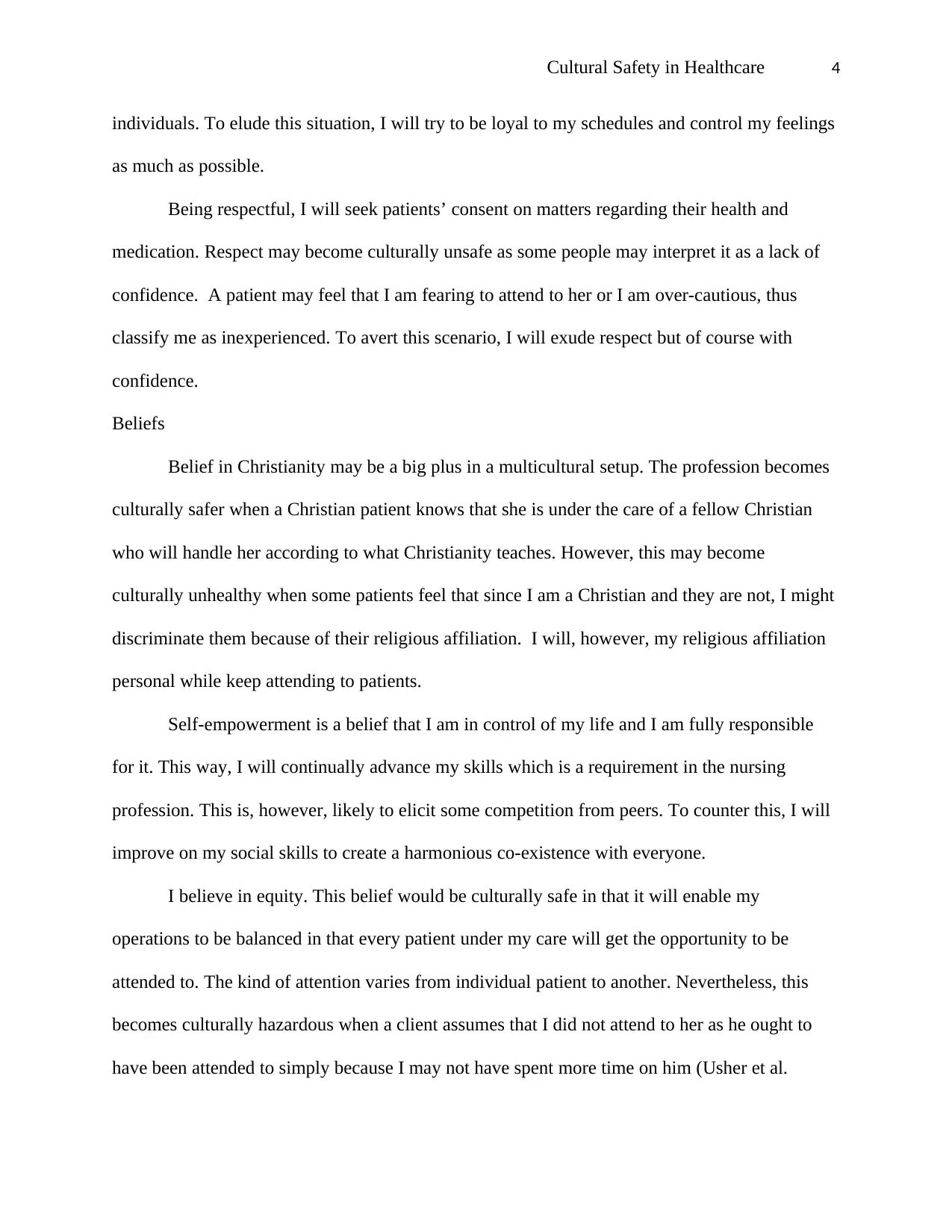
Cultural Safety in Healthcare 4
individuals. To elude this situation, I will try to be loyal to my schedules and control my feelings
as much as possible.
Being respectful, I will seek patients’ consent on matters regarding their health and
medication. Respect may become culturally unsafe as some people may interpret it as a lack of
confidence. A patient may feel that I am fearing to attend to her or I am over-cautious, thus
classify me as inexperienced. To avert this scenario, I will exude respect but of course with
confidence.
Beliefs
Belief in Christianity may be a big plus in a multicultural setup. The profession becomes
culturally safer when a Christian patient knows that she is under the care of a fellow Christian
who will handle her according to what Christianity teaches. However, this may become
culturally unhealthy when some patients feel that since I am a Christian and they are not, I might
discriminate them because of their religious affiliation. I will, however, my religious affiliation
personal while keep attending to patients.
Self-empowerment is a belief that I am in control of my life and I am fully responsible
for it. This way, I will continually advance my skills which is a requirement in the nursing
profession. This is, however, likely to elicit some competition from peers. To counter this, I will
improve on my social skills to create a harmonious co-existence with everyone.
I believe in equity. This belief would be culturally safe in that it will enable my
operations to be balanced in that every patient under my care will get the opportunity to be
attended to. The kind of attention varies from individual patient to another. Nevertheless, this
becomes culturally hazardous when a client assumes that I did not attend to her as he ought to
have been attended to simply because I may not have spent more time on him (Usher et al.
individuals. To elude this situation, I will try to be loyal to my schedules and control my feelings
as much as possible.
Being respectful, I will seek patients’ consent on matters regarding their health and
medication. Respect may become culturally unsafe as some people may interpret it as a lack of
confidence. A patient may feel that I am fearing to attend to her or I am over-cautious, thus
classify me as inexperienced. To avert this scenario, I will exude respect but of course with
confidence.
Beliefs
Belief in Christianity may be a big plus in a multicultural setup. The profession becomes
culturally safer when a Christian patient knows that she is under the care of a fellow Christian
who will handle her according to what Christianity teaches. However, this may become
culturally unhealthy when some patients feel that since I am a Christian and they are not, I might
discriminate them because of their religious affiliation. I will, however, my religious affiliation
personal while keep attending to patients.
Self-empowerment is a belief that I am in control of my life and I am fully responsible
for it. This way, I will continually advance my skills which is a requirement in the nursing
profession. This is, however, likely to elicit some competition from peers. To counter this, I will
improve on my social skills to create a harmonious co-existence with everyone.
I believe in equity. This belief would be culturally safe in that it will enable my
operations to be balanced in that every patient under my care will get the opportunity to be
attended to. The kind of attention varies from individual patient to another. Nevertheless, this
becomes culturally hazardous when a client assumes that I did not attend to her as he ought to
have been attended to simply because I may not have spent more time on him (Usher et al.
Paraphrase This Document
Need a fresh take? Get an instant paraphrase of this document with our AI Paraphraser
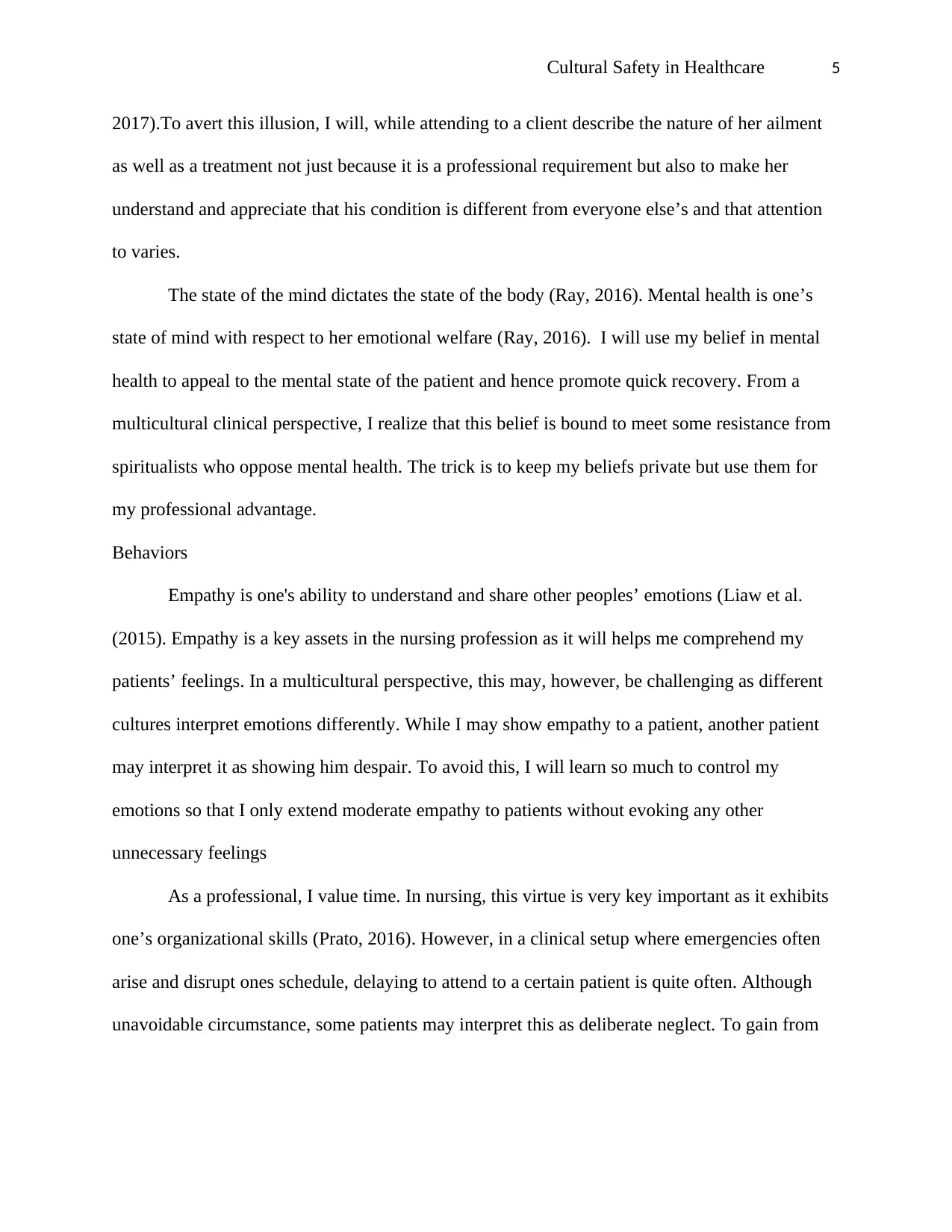
Cultural Safety in Healthcare 5
2017).To avert this illusion, I will, while attending to a client describe the nature of her ailment
as well as a treatment not just because it is a professional requirement but also to make her
understand and appreciate that his condition is different from everyone else’s and that attention
to varies.
The state of the mind dictates the state of the body (Ray, 2016). Mental health is one’s
state of mind with respect to her emotional welfare (Ray, 2016). I will use my belief in mental
health to appeal to the mental state of the patient and hence promote quick recovery. From a
multicultural clinical perspective, I realize that this belief is bound to meet some resistance from
spiritualists who oppose mental health. The trick is to keep my beliefs private but use them for
my professional advantage.
Behaviors
Empathy is one's ability to understand and share other peoples’ emotions (Liaw et al.
(2015). Empathy is a key assets in the nursing profession as it will helps me comprehend my
patients’ feelings. In a multicultural perspective, this may, however, be challenging as different
cultures interpret emotions differently. While I may show empathy to a patient, another patient
may interpret it as showing him despair. To avoid this, I will learn so much to control my
emotions so that I only extend moderate empathy to patients without evoking any other
unnecessary feelings
As a professional, I value time. In nursing, this virtue is very key important as it exhibits
one’s organizational skills (Prato, 2016). However, in a clinical setup where emergencies often
arise and disrupt ones schedule, delaying to attend to a certain patient is quite often. Although
unavoidable circumstance, some patients may interpret this as deliberate neglect. To gain from
2017).To avert this illusion, I will, while attending to a client describe the nature of her ailment
as well as a treatment not just because it is a professional requirement but also to make her
understand and appreciate that his condition is different from everyone else’s and that attention
to varies.
The state of the mind dictates the state of the body (Ray, 2016). Mental health is one’s
state of mind with respect to her emotional welfare (Ray, 2016). I will use my belief in mental
health to appeal to the mental state of the patient and hence promote quick recovery. From a
multicultural clinical perspective, I realize that this belief is bound to meet some resistance from
spiritualists who oppose mental health. The trick is to keep my beliefs private but use them for
my professional advantage.
Behaviors
Empathy is one's ability to understand and share other peoples’ emotions (Liaw et al.
(2015). Empathy is a key assets in the nursing profession as it will helps me comprehend my
patients’ feelings. In a multicultural perspective, this may, however, be challenging as different
cultures interpret emotions differently. While I may show empathy to a patient, another patient
may interpret it as showing him despair. To avoid this, I will learn so much to control my
emotions so that I only extend moderate empathy to patients without evoking any other
unnecessary feelings
As a professional, I value time. In nursing, this virtue is very key important as it exhibits
one’s organizational skills (Prato, 2016). However, in a clinical setup where emergencies often
arise and disrupt ones schedule, delaying to attend to a certain patient is quite often. Although
unavoidable circumstance, some patients may interpret this as deliberate neglect. To gain from
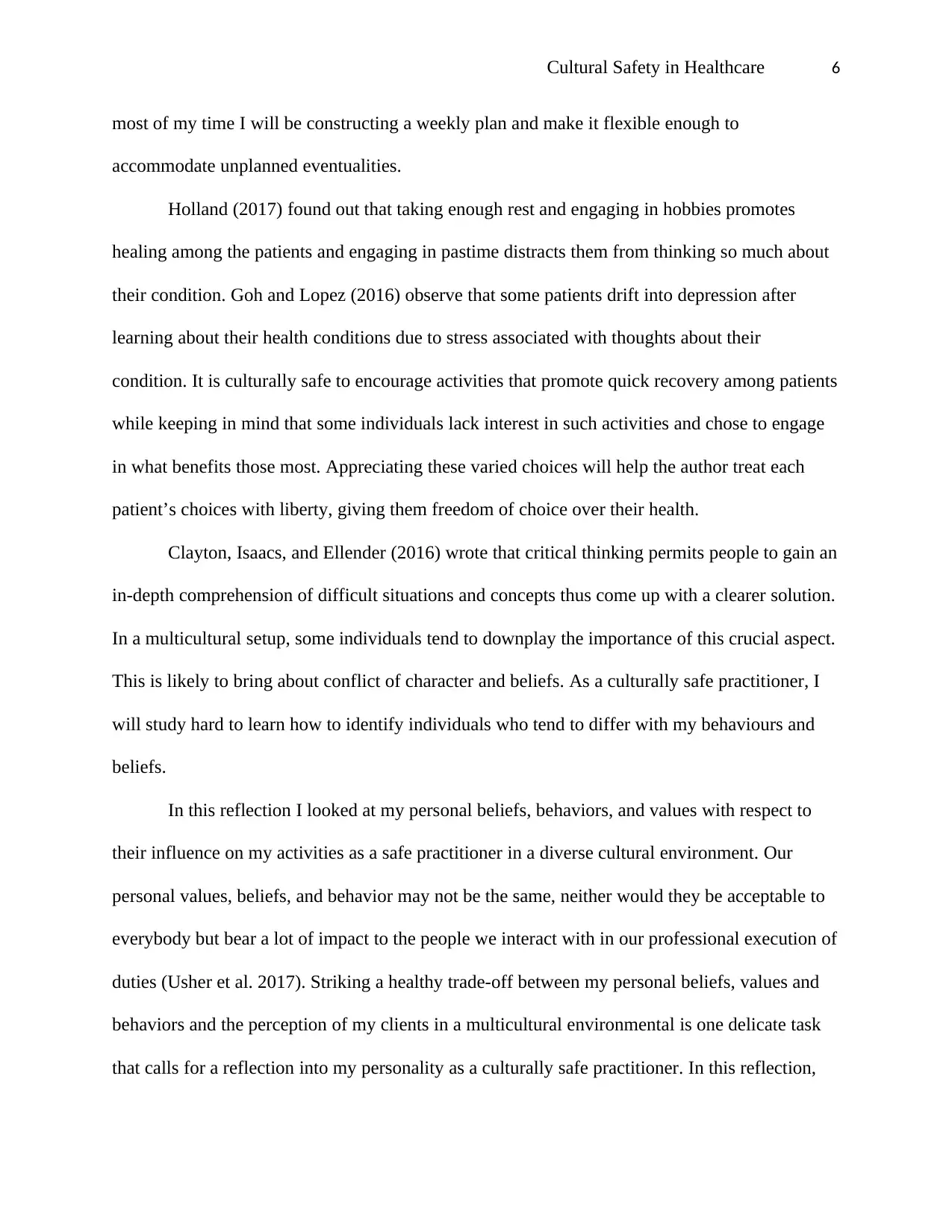
Cultural Safety in Healthcare 6
most of my time I will be constructing a weekly plan and make it flexible enough to
accommodate unplanned eventualities.
Holland (2017) found out that taking enough rest and engaging in hobbies promotes
healing among the patients and engaging in pastime distracts them from thinking so much about
their condition. Goh and Lopez (2016) observe that some patients drift into depression after
learning about their health conditions due to stress associated with thoughts about their
condition. It is culturally safe to encourage activities that promote quick recovery among patients
while keeping in mind that some individuals lack interest in such activities and chose to engage
in what benefits those most. Appreciating these varied choices will help the author treat each
patient’s choices with liberty, giving them freedom of choice over their health.
Clayton, Isaacs, and Ellender (2016) wrote that critical thinking permits people to gain an
in-depth comprehension of difficult situations and concepts thus come up with a clearer solution.
In a multicultural setup, some individuals tend to downplay the importance of this crucial aspect.
This is likely to bring about conflict of character and beliefs. As a culturally safe practitioner, I
will study hard to learn how to identify individuals who tend to differ with my behaviours and
beliefs.
In this reflection I looked at my personal beliefs, behaviors, and values with respect to
their influence on my activities as a safe practitioner in a diverse cultural environment. Our
personal values, beliefs, and behavior may not be the same, neither would they be acceptable to
everybody but bear a lot of impact to the people we interact with in our professional execution of
duties (Usher et al. 2017). Striking a healthy trade-off between my personal beliefs, values and
behaviors and the perception of my clients in a multicultural environmental is one delicate task
that calls for a reflection into my personality as a culturally safe practitioner. In this reflection,
most of my time I will be constructing a weekly plan and make it flexible enough to
accommodate unplanned eventualities.
Holland (2017) found out that taking enough rest and engaging in hobbies promotes
healing among the patients and engaging in pastime distracts them from thinking so much about
their condition. Goh and Lopez (2016) observe that some patients drift into depression after
learning about their health conditions due to stress associated with thoughts about their
condition. It is culturally safe to encourage activities that promote quick recovery among patients
while keeping in mind that some individuals lack interest in such activities and chose to engage
in what benefits those most. Appreciating these varied choices will help the author treat each
patient’s choices with liberty, giving them freedom of choice over their health.
Clayton, Isaacs, and Ellender (2016) wrote that critical thinking permits people to gain an
in-depth comprehension of difficult situations and concepts thus come up with a clearer solution.
In a multicultural setup, some individuals tend to downplay the importance of this crucial aspect.
This is likely to bring about conflict of character and beliefs. As a culturally safe practitioner, I
will study hard to learn how to identify individuals who tend to differ with my behaviours and
beliefs.
In this reflection I looked at my personal beliefs, behaviors, and values with respect to
their influence on my activities as a safe practitioner in a diverse cultural environment. Our
personal values, beliefs, and behavior may not be the same, neither would they be acceptable to
everybody but bear a lot of impact to the people we interact with in our professional execution of
duties (Usher et al. 2017). Striking a healthy trade-off between my personal beliefs, values and
behaviors and the perception of my clients in a multicultural environmental is one delicate task
that calls for a reflection into my personality as a culturally safe practitioner. In this reflection,
⊘ This is a preview!⊘
Do you want full access?
Subscribe today to unlock all pages.

Trusted by 1+ million students worldwide
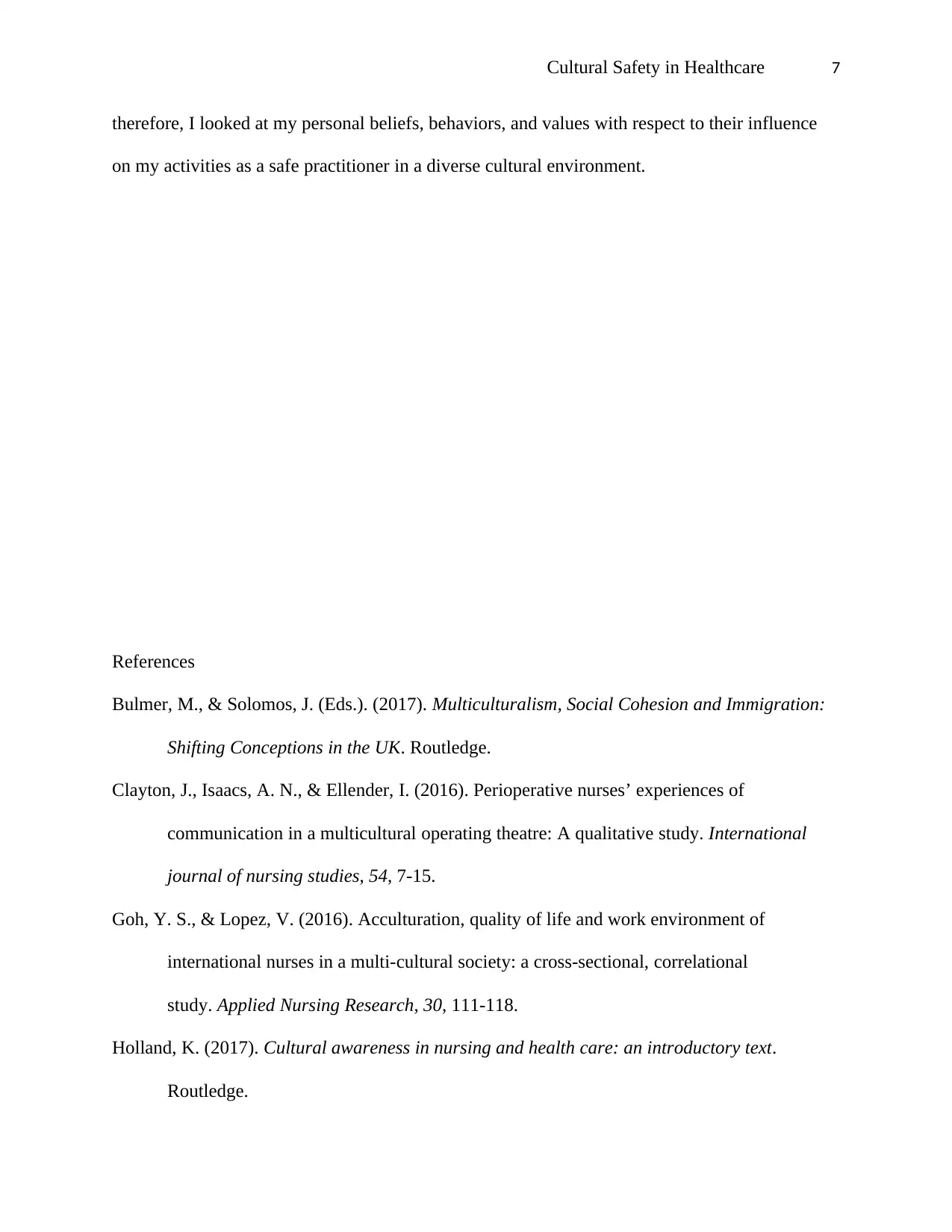
Cultural Safety in Healthcare 7
therefore, I looked at my personal beliefs, behaviors, and values with respect to their influence
on my activities as a safe practitioner in a diverse cultural environment.
References
Bulmer, M., & Solomos, J. (Eds.). (2017). Multiculturalism, Social Cohesion and Immigration:
Shifting Conceptions in the UK. Routledge.
Clayton, J., Isaacs, A. N., & Ellender, I. (2016). Perioperative nurses’ experiences of
communication in a multicultural operating theatre: A qualitative study. International
journal of nursing studies, 54, 7-15.
Goh, Y. S., & Lopez, V. (2016). Acculturation, quality of life and work environment of
international nurses in a multi-cultural society: a cross-sectional, correlational
study. Applied Nursing Research, 30, 111-118.
Holland, K. (2017). Cultural awareness in nursing and health care: an introductory text.
Routledge.
therefore, I looked at my personal beliefs, behaviors, and values with respect to their influence
on my activities as a safe practitioner in a diverse cultural environment.
References
Bulmer, M., & Solomos, J. (Eds.). (2017). Multiculturalism, Social Cohesion and Immigration:
Shifting Conceptions in the UK. Routledge.
Clayton, J., Isaacs, A. N., & Ellender, I. (2016). Perioperative nurses’ experiences of
communication in a multicultural operating theatre: A qualitative study. International
journal of nursing studies, 54, 7-15.
Goh, Y. S., & Lopez, V. (2016). Acculturation, quality of life and work environment of
international nurses in a multi-cultural society: a cross-sectional, correlational
study. Applied Nursing Research, 30, 111-118.
Holland, K. (2017). Cultural awareness in nursing and health care: an introductory text.
Routledge.
Paraphrase This Document
Need a fresh take? Get an instant paraphrase of this document with our AI Paraphraser
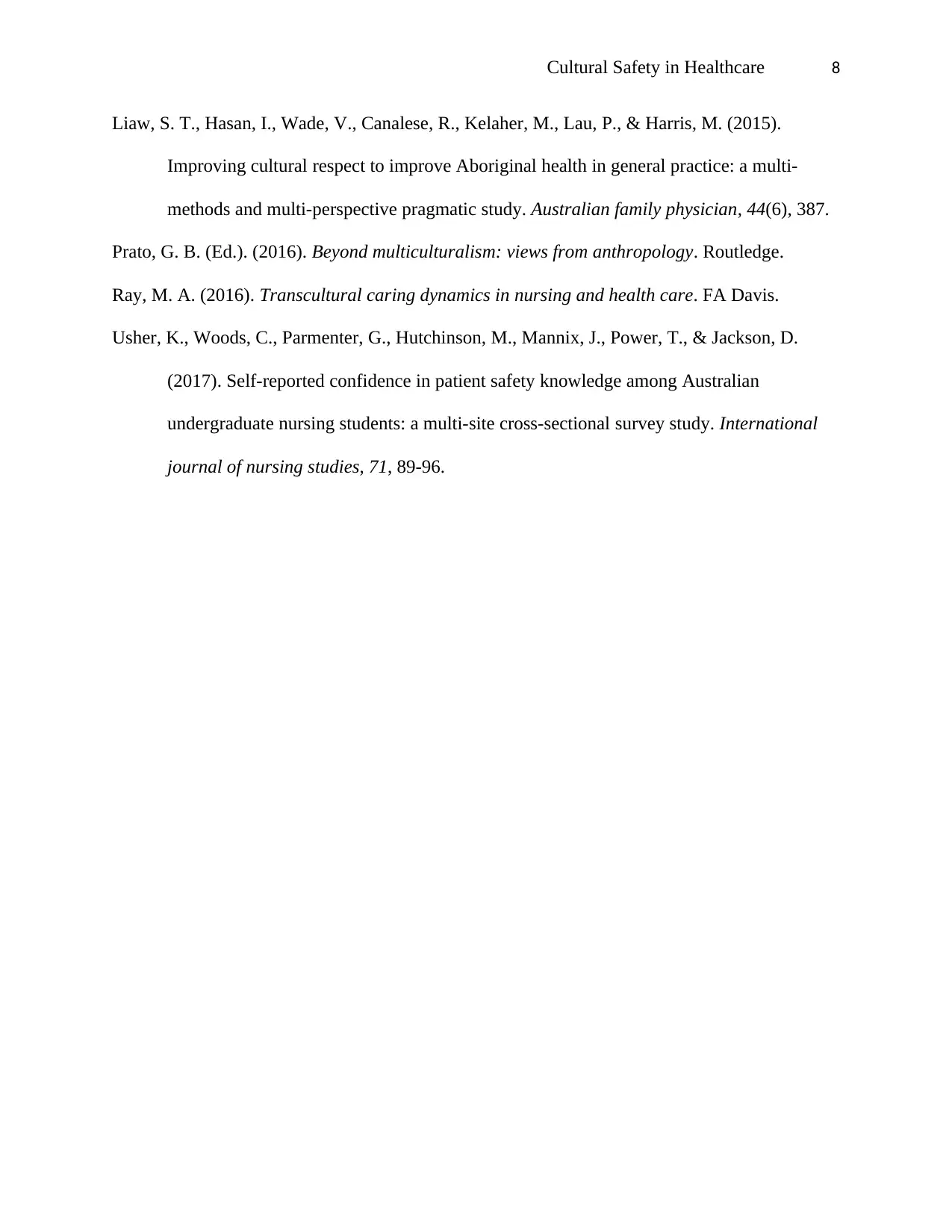
Cultural Safety in Healthcare 8
Liaw, S. T., Hasan, I., Wade, V., Canalese, R., Kelaher, M., Lau, P., & Harris, M. (2015).
Improving cultural respect to improve Aboriginal health in general practice: a multi-
methods and multi-perspective pragmatic study. Australian family physician, 44(6), 387.
Prato, G. B. (Ed.). (2016). Beyond multiculturalism: views from anthropology. Routledge.
Ray, M. A. (2016). Transcultural caring dynamics in nursing and health care. FA Davis.
Usher, K., Woods, C., Parmenter, G., Hutchinson, M., Mannix, J., Power, T., & Jackson, D.
(2017). Self-reported confidence in patient safety knowledge among Australian
undergraduate nursing students: a multi-site cross-sectional survey study. International
journal of nursing studies, 71, 89-96.
Liaw, S. T., Hasan, I., Wade, V., Canalese, R., Kelaher, M., Lau, P., & Harris, M. (2015).
Improving cultural respect to improve Aboriginal health in general practice: a multi-
methods and multi-perspective pragmatic study. Australian family physician, 44(6), 387.
Prato, G. B. (Ed.). (2016). Beyond multiculturalism: views from anthropology. Routledge.
Ray, M. A. (2016). Transcultural caring dynamics in nursing and health care. FA Davis.
Usher, K., Woods, C., Parmenter, G., Hutchinson, M., Mannix, J., Power, T., & Jackson, D.
(2017). Self-reported confidence in patient safety knowledge among Australian
undergraduate nursing students: a multi-site cross-sectional survey study. International
journal of nursing studies, 71, 89-96.
1 out of 8
Related Documents
Your All-in-One AI-Powered Toolkit for Academic Success.
+13062052269
info@desklib.com
Available 24*7 on WhatsApp / Email
![[object Object]](/_next/static/media/star-bottom.7253800d.svg)
Unlock your academic potential
Copyright © 2020–2025 A2Z Services. All Rights Reserved. Developed and managed by ZUCOL.



